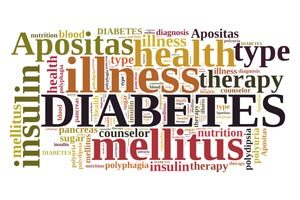
Understanding diabetes
Our cells need sugar for their energy needs. When we eat, the carbohydrates are converted into glucose and rapidly absorbed into the bloodstream. When the glucose levels in the blood rise, it signals the pancreas to make and release insulin. Insulin helps the cells to sponge up the sugar in the blood. Without insulin, the glucose is unable to slip into the cells and it floats around in the blood. Diabetes occurs when the body can’t make enough insulin or can’t properly use the insulin it makes.
There are two main types of diabetes: Type 1 and type 2. In type 1 diabetes, the immune system attacks and permanently disables the insulin-making cells in the pancreas.
In type 2 diabetes, the cells stop responding to insulin’s open-up-for-glucose signal. When this happens, the pancreas sends out more insulin in an attempt to force the blood sugar into cells. Eventually, the insulin-making cells get exhausted and begin to fail. Type2 diabetes has a slow onset, sometimes taking decades to develop into full-blown diabetes.
Why diabetes is dangerous

Right now, approximately one in three Americans over the age of 20 already have pre-diabetes. Please note that age. It’s scary to think that people just out of their teens are becoming predisposed to this troublesome disease. What’s more scary is that only 10 percent of these people know that they are in the pre-diabetic stage. The good news is…
Type 2 diabetes can be easily prevented
There has been a lot of debate over the years on whether it’s better to prevent diabetes with drugs or with lifestyle changes. Landmark research published in the New England Journal of Medicine has effectively put that debate to rest.
In this four-year study, 3,234 participants (average age 51) who were non-diabetic but had slightly elevated levels of blood sugar were divided into three groups. The first group was given placebo, the second group was given a blood sugar-controlling drug – Metformin, twice daily. The third group was subjected to lifestyle changes that included a low-calorie, low-fat diet and moderate exercise (brisk walking for 20 minutes daily).
At the end of four years, researchers found that lifestyle intervention reduced the incidence of diabetes by 58 percent (compared to the placebo) while the drug intervention reduced the incidence of diabetes by only 31 percent. It must be noted here that the 58 percent reduction in the lifestyle group was over the entire group and not just those who diligently followed the diet and exercise regimen.
In fact, in another similar study, the researchers went one step further and divided the lifestyle group into those who stuck to the program religiously and those who didn’t. And the result? Every single one of the people who followed the diet and exercise program did not develop diabetes. Can you believe that? Not one of them developed diabetes.
And in case you’re thinking that diabetes runs in your family, let me assure you – though the genes you inherit may influence the development of type 2 diabetes, they take a back seat to behavioral and lifestyle factors.
Other studies following this landmark study all came to the same conclusion: Non-drug approaches were superior to drug-based approaches for diabetes prevention. Clearly, preventing diabetes naturally is the way forward.
Strategies for preventing diabetes
As all these studies prove that diabetes is such a highly preventable disease, why don’t we all just go and prevent it, instead of worrying about it. Sounds like a plan? Good. Rather than give you a few tips for diabetes prevention, I would like to share with you two successful strategies for preventing diabetes.
Excess weight is the single most important cause of type 2 diabetes. Being obese makes you 20 to 40 times more likely to develop diabetes than someone with a healthy weight. Since the best way to lose weight is a healthy diet and exercise, let’s break it down further: What comprises a healthy diet and what makes for enough exercise.
Strategy No. 1: Control your diet to prevent diabetes
Though it is a must to cut down on sweet stuff like cakes, candies and sugary beverages (coffee, tea, pop), just cutting down on sugar is not enough. It has to go hand-in-hand with eating the right food.
The food we eat can be broken down into six basic food groups – protein, grains, dairy, vegetable, fruit and fat. Here are the best and worst options in each group. Moving your choices from the worst group to the best group in each of these food categories will go a long way in preventing diabetes.
Best protein: Choose lean proteins like fish or turkey that are low in saturated fat. Some fish, like salmon, have the added benefit of containing heart-healthy omega-3 fats. Beans are an excellent source of protein for vegetarians. Experiment with the wide variety of beans from flat beans to chick peas to fava beans. Worst protein: Processed deli meats which have high amounts of fat and sodium.
Best grains: Whole grains are rich in fiber content which is good for digestion. They also contain healthy vitamins, minerals and phytochemicals. Choose from wild rice, quinoa, cereals and whole grain breads. Worst grains: Refined white flour doesn’t contain the same health benefits as whole grains. Processed foods made with white flour include breakfast cereals, white bread, pasta and pastries.
Best dairy: Plain non-fat Greek yogurt is a healthy dairy option as it contains only six to eight grams of carbohydrates in a serving. It’s also very versatile and you can use it in recipes as a replacement for sour cream, which is high in saturated fat. Worst dairy: Avoid all full-fat dairy products like sour cream, packaged chocolate milk, high-fat cheese.
Best vegetables: Eat a lot (at least half your dinner plate) of non-starchy vegetables such as leafy greens, broccoli, cauliflower, asparagus and carrots. They are low in carbohydrates and high in fiber and other nutrients. Worst vegetables: Starchy vegetables such as corn, potatoes,and peas. These items are nutritious, but should be eaten in moderation.
Best fruit: Fresh fruit can conquer your craving for sweets while providing antioxidants and fiber. Berries are a great option because as the recommended portion sizes are typically generous, you end up feeling satisfied. Worst fruit: Canned fruits have high sugar content. Even dried fruits and fruit juices could have a very high sugar concentration. It’s also good to remember that most canned and bottled products don’t contain the same nutrients as whole fruit.
Best fats: The best type of fats are monounsaturated fats found in avocados, almonds and pecans, or the polyunsaturated fats found in walnuts and sunflower oil, which can help to lower bad cholesterol. Worst fats: Saturated fats increase bad cholesterol, so limit butter, cheese, gravy and fried foods. Trans-fats are even worse than saturated fats, so avoid them as much as possible. Look for the term “hydrogenated” on labels of processed food packages and avoid them.
Strategy No. 2: Avoiding diabetes with exercise
The idea here is to keep all your muscles active, every day. Take a brisk walk for half an hour daily. If you’re living in a high-rise building, take the elevator to the floor below where you live and climb the stairs to your floor.
Remember, every two hours you watch TV instead of doing something more active, increases you chances of developing diabetes by 20 percent. This could also be due to the fact that watching TV is associated with unnecessary snacking.
Say no to smoking
Say yes to alcohol
You read right. Moderate amounts of alcohol – a drink a day for women and two drinks a day for men – increases the efficiency of insulin at getting glucose inside cells. However, higher amounts of alcohol could increase diabetes risk. If you don’t already drink alcohol, please don’t start. The same benefits (in fact better) that alcohol can deliver can be achieved by exercising regularly.
As you can see, preventing this dreaded disease is no big deal. But in spite of all the programs the government is introducing to fight it, the incidence of diabetes has almost doubled in the last 10 years.
The fact that such an easily preventable disease is growing at such a rapid rate is clearly our collective fault. Let’s make amends. Let’s start by staying lean and healthy. Let’s defeat diabetes!
Related Reading:
Eating more of this will help prevent diabetes
Dairy is good for your whole body – heart, bones, teeth – and a new study has singled out this particular food from the dairy group for its ability to lower your risk of type 2 diabetes. Find out what you should be eating here.
Warning: One of the biggest risks that comes with diabetes
It’s truly alarming how so many people with diabetes – or at risk for diabetes – are unaware of the damage the condition can do to this organ. Read more about diabetes damage here.
The simple beverage swap to reduce risk of diabetes
We all know we should be drinking water throughout our day, but a lot of us are still grabbing a can or bottle of soda. It’s no secret that Americans…Read more
The buzz surrounding quinoa (pronounced KEEN-wah) doesn’t seem to be slowing down. Quinoa has been hailed a superfood and for good reason, too. Its high protein and fiber content, along with being gluten-free, has given it quite the star power. Continue reading…